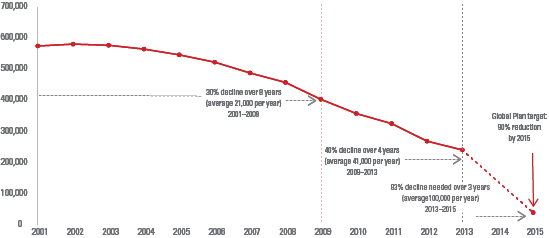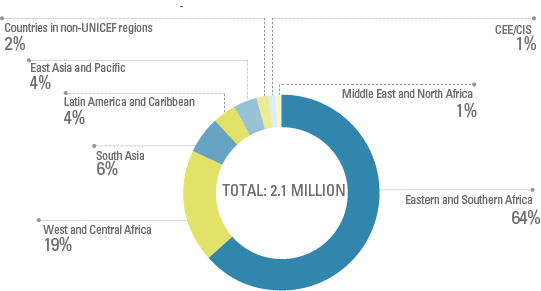An estimated 35.0 million people were living with HIV worldwide in 2013. Of these, 3.2 million were children under 15 years of age and about 17.6 million were women and girls. Each day that year, nearly 6,000 people were newly infected with HIV and approximately 4,200 people died from AIDS, mostly because of inadequate access to HIV prevention care and treatment services. However, new HIV infections among children are declining rapidly, largely due to scaled-up efforts to prevent mother-to-child transmission.
The toll of HIV and AIDS continues to be harsh, especially in sub-Saharan Africa. Worldwide in 2013, the region accounted for the vast majority of people living with AIDS, new HIV infections and AIDS-related deaths. In that region, HIV is spread primarily through heterosexual sex. In 2013, nearly three times as many adolescent girls in sub-Saharan Africa were newly infected with HIV than boys in the same age group (15 to 19 years).
GLOBAL TRENDS
As of 2013, roughly 17.7 million children under the age of 18 had lost one or both parents to AIDS. Millions more have been affected by the epidemic, through a heightened risk of poverty, homelessness, school dropout, discrimination and loss of opportunities. These hardships include prolonged illness and death. Of the estimated 1.5 million people who died of AIDS-related illnesses in 2013, 190,000 of them were children under 15 years of age.
The global AIDS epidemic continues to affect millions of people, regardless of their age or sex
Global HIV and AIDS epidemiological estimates for 2013
|
Global Summary of the AIDS Epidemic, 2013
|
|
People living with HIV in 2013
|
|
All ages
|
35.0 million [33.2 million–37.2 million]
|
|
Adults (aged 15+)
|
31.8 million [30.1 million–33.7 million]
|
|
Women (aged 15+)
|
16.0 million [15.2 million–17.0 million]
|
|
Children (aged 0–14)
|
3.2 million [2.9 million–3.5 million]
|
|
Adolescents (aged 10–19)
|
2.1 million [1.9 million–2.3 million]
|
|
People newly infected with HIV in 2013
|
|
All ages
|
2.1 million [1.9 million–2.4 million]
|
|
Adults (aged 15+)
|
1.9 million [1.7 million–2.1 million]
|
|
Women (aged 15+)
|
900,000 [790,000–1.0 million]
|
|
Children (aged 0–14)
|
240,000 [210,000–280,000]
|
|
Adolescents (aged 10–19)
|
250,000 [210,000–300,000]
|
|
AIDS deaths in 2013
|
|
All ages
|
1.5 million [1.4 million–1.7 million]
|
|
Adults (aged 15+)
|
1.3 million [ 1.2 million–1.5 million]
|
|
Women (aged 15+)
|
600,000 [550,000–670,000]
|
|
Children (aged 0–14)
|
190,000 [170,000–220,000]
|
|
Adolescents (aged 10–19)
|
120,000 [100,000–130,000]
|
Note: The numbers in brackets are ranges around the estimates that define the boundaries within which the actual numbers lie, based on the best available information.
Source: UNAIDS, 2013 HIV and AIDS estimates.
In 2013, around 240,000 children were newly infected with HIV, bringing the total number of children under age 15 living with HIV to 3.2 million. More than 90 per cent of these children live in sub-Saharan Africa.
One bright spot on the global horizon is the rapid decline of nearly 60% in new HIV infection among children (aged 0-14) since 2001, largely due to stepped-up efforts to prevent mother-to-child transmission of HIV. Progress must accelerate even further, however, to meet the 2015 target of a 90 per cent reduction in new infections among children. The target was set at the UN General Assembly High-level Meeting on AIDS in 2011 as part of a Global Plan.
REGIONAL TRENDS
Sub-Saharan Africa, particularly Southern Africa, remains the region most heavily affected by the epidemic. In 2013, sub-Saharan Africa accounted for about 71 per cent of people living with HIV worldwide, nearly 70 per cent of new HIV infections, and approximately 74 per cent of all AIDS-related deaths. The spread of HIV in sub-Saharan Africa is mostly through heterosexual relationships, both in the context of transactional and commercial sex and in longer-term relationships, including marriage.
In most other regions of the world, HIV disproportionately affects persons who inject drugs, men who have sex with men and sex workers. The epidemic is evolving, however, and national epidemics throughout the world are experiencing important transitions. In Eastern Europe and Central Asia, HIV epidemics that were once distinguished largely by transmission among persons who inject drugs are now increasingly characterized by significant sexual transmission. In parts of Asia, they are more and more characterized by transmission among heterosexual couples. In Asia as a whole, HIV epidemics have long been concentrated in persons who inject drugs, sex workers and their clients, and men who have sex with men. Now, they are steadily expanding into lower-risk populations through transmission to the sexual partners of those most at risk.
Adolescents aged 15 to 19 account for an estimated 12 per cent of new HIV infections worldwide. Globally, in 2013, adolescent girls accounted for nearly two thirds of all new HIV infections among adolescents. In sub-Saharan Africa that year, nearly three times as many adolescent girls were newly infected with HIV than adolescent boys. In only three UNICEF regions – Middle East and North Africa, South Asia and Latin America and the Caribbean – are more adolescent boys infected with HIV than adolescent girls. This reflects differences in risk behaviour in these regions, which means that interventions must be tailored to the specific nature and dynamic of the epidemic.
For more data and analysis on HIV and AIDS in children, see UNICEF’s Children and AIDS: Sixth stocktaking report by clicking here.
REFERENCES
UNICEF, Children and AIDS: Sixth stocktaking report, UNICEF, New York, 2013.
UNAIDS, Report on the Global AIDS Epidemic, UNAIDS, Geneva, 2013.
UNICEF, Progress for Children: A report card on adolescents, No. 10, UNICEF New York, 2012.
UNICEF, Progress for Children: Achieving the MDGs with equity, No. 9, UNICEF New York, 2010.
UNICEF, The State of the World’s Children 2014 In Numbers: Every Child Counts; Revealing disparities, advancing children’s rights, UNICEF, New York, 2014.
UNICEF, The State of the World’s Children 2013: Children with disabilities, UNICEF, New York, 2013.
UNICEF, UNAIDS, UNESCO, UNFPA, ILO, WHO and The World Bank, Opportunity in Crisis: Preventing HIV from early adolescence to young adulthood, UNICEF, New York, 2011.
WHO, Global Update on HIV Treatment 2013: Results, impact and opportunities, WHO, Geneva, 2013.
WHO, UNAIDS and UNICEF, Global HIV/AIDS Response: Epidemic update and health sector progress towards universal access – Progress report 2011, UNAIDS, Geneva, 2011.




